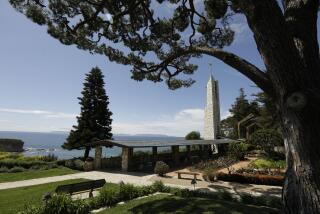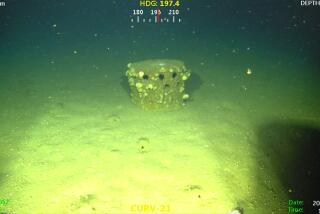Mystery of Undersea Stones : Ancient Anchors or Archeological Hoax?
It’s a quarter-mile off the Palos Verdes Peninsula, 25 feet down.
That’s about all Bob Meistrell and Wayne Baldwin will tell you about the site they dive to as often as they can. They want to protect the area that some scientists say contains invaluable artifacts, a set of unusual stones that may reveal much about local history.
The 30-odd stones, scattered across two-thirds of an acre on the ocean floor, weigh between 100 and 1,000 pounds each and measure on average three to four feet across. Although they take various forms--some shaped like donuts, others like barrels or pickles--they are all characterized by a round hole bored through the center.
Since Meistrell and Baldwin first found the stones in 1974, they have sparked intense debate within the scientific community. Originally touted by some archeologists as ancient Chinese anchors, the stones were widely considered as evidence that Asians discovered the New World thousands of years before Columbus.
Other archeologists--and geologists, paleontologists, zoologists, oceanographers and historians--have flocked to the site over the past 10 years to study the stones both in and out of the water--five were hoisted from the ocean bottom--and to retrieve samples for laboratory work.
Differing Theories
Many of the researchers have scoffed at the Chinese anchor theory and have offered their own hypotheses. Some believe the stones to be anchors made by 19th-Century Chinese fishermen; others think they were used by 19th-Century Portuguese whalers. Still another scientist holds that the mysterious stones were formed naturally and contain no mystery at all; they are evidence only of a colossal archeological hoax.
The scientists will have the chance to air their conflicting theories next week at a conference of the Society for Historic Archeology and Council on Underwater Archeology. At the Sacramento gathering, Otto Orzech, a doctoral candidate in oceanography who has studied the stones for five years, will present a paper on the research to date.
A cautious researcher, Orzech has made about a dozen diving trips to map the site and remains one of the few scientists who does not hold fast to any particular theory. Any of the current interpretations may be correct, he allows, or none of them.
“Nothing tells you when the stones were carved,” Orzech said recently. “You have to be careful. You can jump on the bandwagon and be completely wrong. You should wait until all the evidence is there.”
Chinese Quarry
Magazines and newspapers worldwide jumped on the ancient-Chinese theory when two San Diego archeologists announced their findings in 1981. James R. Moriarty, a professor at the University of San Diego, and one of his former students, Larry Pierson, had samples of the stones analyzed at various colleges in the U.S., Taiwan and the Republic of China. Their research showed that the stones came from a Chinese quarry, they said.
Between 1500 and 3000 BC, the Chinese used such stones as anchors on their trans-Pacific voyages to the New World, Pierson said in an interview. The anchors were lost off the Palos Verdes coast when a number of ships sank during a storm in about 2250 BC, he theorized.
He used a “simple archeological process” to reach those conclusions, Pierson said. “You take the artifacts, match them against an established scale and see where they fit. It doesn’t take a brain surgeon to figure this stuff out.
“Other scientists have been led astray because they lack experience in the field or they’re looking to get their name in print.”
Frank J. Frost, a historian and archeologist at the University of California, Santa Barbara, said he was lured into the controversy by “some of the very wild theories” he had seen in print.
San Pedro Fishermen
Frost’s theory, published in a 1982 issue of Archeology magazine, agrees that the stones were indeed anchors, but says that they belonged to 19th-Century Chinese fishermen living in the San Pedro area.
“The ancient Chinese theory is disproven because the rock is local,” Frost said in a telephone interview. Laboratory analyses at UC Santa Barbara, he said, have confirmed the stones to be Monterey shale, rock common to the California coast.
But a graduate student in geology at California State University, Northridge, who has also been studying the stones says they come from the Monterey formation, a rock found in the Palos Verdes area, not Monterey shale, which is found north of Santa Barbara.
“I’d hazard a guess it’s a local rock,” said Nikki Vaughan, who keeps two of the stones in her office at the university. Further research would conclusively disprove the ancient-Chinese-anchor theory, she said, but a lack of funding has hampered the study.
Vaughan says that her analyses have shown that the stones were carved by man, and not formed naturally. The chemical composition of the stones does not match those of the rock formations underwater, she said, indicating that the rocks were brought to the site by man.
Portuguese Whalers
An Escondido anthropologist and archeologist, Paul G. Chace, also believes that the stones were man-made, but not by Chinese, ancient or modern. Chace, who specializes in the study of the Chinese who traveled to the New World, says the stones were carved by 19th-Century Portuguese who hunted whales along the Palos Verdes coast.
“I’ve explored each of the possibilities and found only one to be reasonable,” Chace said. “Pierson and Moriarty looked at one alternative and it doesn’t wash.”
The stones may have been used as weights to anchor whales at sea after they were killed, Chace said, or as part of a pulley system to drag the creatures ashore. Today, sailors in the Azores off the coast of Portugal use anchors just like the Palos Verdes stones, he said.
The stones reflect “part of an important early California industry,” the archeologist said. “The South Bay can pridefully claim them as part of the local heritage.”
Long Beach oceanographer William Bascom has still another theory and says talk of the stones as anchors is “absolute madness.”
Rolling Anchors
“If there’s anything you don’t want on a sailing ship, it’s something that would roll,” Bascom said. “If you said that in a yacht club, they’d laugh you off the stage. Anchors are made as flat as they can be.”
Bascom read Frank Frost’s account in Archeology magazine and in a letter to the editor contended that the stones were formed naturally, from the excretions of shrimp living on the ocean floor.
“Shrimp come out of their burrows at night to forage,” Frost explained in a phone interview. “When they come back to their homes, they defecate, leaving an increasing amount of calcium.” After a while, donut-like rings form around the burrows, creating rocks like those found by Meistrell and Baldwin, Bascom said.
The stones have “no value at all as an archeological find,” he said. “People stumbled on strange stones and said maybe they’re anchors. They never really gave it much thought.”
The studies of the rocks cannot rightly be called research, he said, but “crackpot archeology.”
Carved by Man
Still, most of the researchers--unlike Bascom--believe that the stones were carved by man. Jack Hunter, a marine archeologist in San Pedro, noted that stones resembling those in the Palos Verdes site have been found in other locations off the coast and some of these may have formed naturally.
“But the stones in contention are definitely of man-made origin,” he said. As for their age, “my feeling is they’re not thousands of years old--more likely hundreds, if that old.”
Only publication of scientific tests will put the questions to rest, Hunter said. “People only claim to have made tests, but they haven’t been published anywhere. The way science works, you have to publish your research. Otherwise it’s just hearsay.”
In the meantime, a few broken stones lay in the boat yard at Meistrell’s dive shop, Dive ‘n’ Surf in Redondo Beach. A pickle-shaped stone sits on display in the Point Vicente Interpretive Center, a small museum in Rancho Palos Verdes. A sign identifies it as “a stone anchor of the type used by Chinese ships more than 2,000 years ago.”
Protect Site
Orzech, Meistrell and others continue to make periodic dives at the site to further document the find. And Meistrell says he is trying to lease the area from the state to prevent people from removing the stones.
“I’m trying to protect the site,” he said. “Wayne and I--we found it and we haven’t sold the stones. A lot of people would give a lot of money for them.”
Archeologist Jack Hunter agrees that, at least until the controversy is settled, the stones should be protected “from people who will try to drag them off to their own garage.”
As for the many interpretations of the stones’ origin, “It’s all still theory,” Hunter says. “Whether the anchor stones mystery goes through time or is resolved within the lifetime of the discoverers, remains to be seen. It’s a detective game. That’s the exciting part of archeology.”






